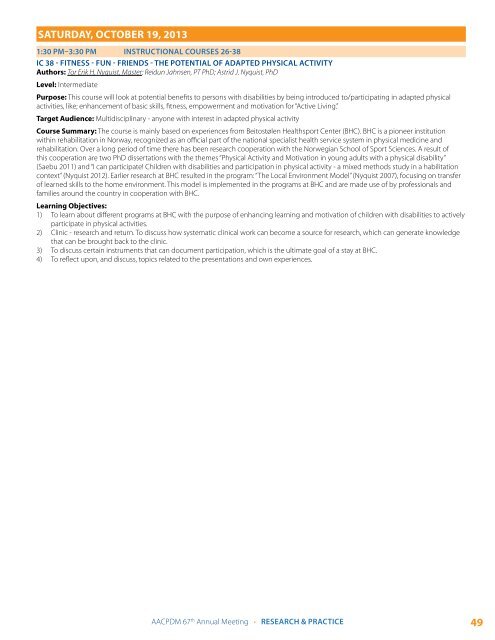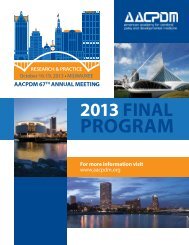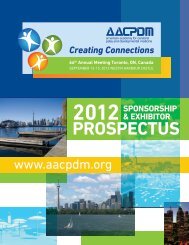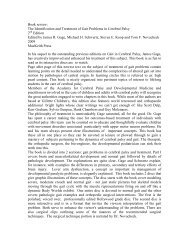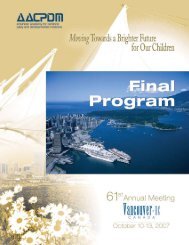program - American Academy for Cerebral Palsy and ...
program - American Academy for Cerebral Palsy and ...
program - American Academy for Cerebral Palsy and ...
Create successful ePaper yourself
Turn your PDF publications into a flip-book with our unique Google optimized e-Paper software.
Saturday, October 19, 2013<br />
1:30 pm–3:30 pm Instructional Courses 26-38<br />
IC 38 - FITNESS - FUN - FRIENDS - THE POTENTIAL OF ADAPTED PHYSICAL ACTIVITY<br />
Authors: Tor Erik H. Nyquist, Master; Reidun Jahnsen, PT PhD; Astrid J. Nyquist, PhD<br />
Level: Intermediate<br />
Purpose: This course will look at potential benefits to persons with disabilities by being introduced to/participating in adapted physical<br />
activities, like; enhancement of basic skills, fitness, empowerment <strong>and</strong> motivation <strong>for</strong> “Active Living.”<br />
Target Audience: Multidisciplinary - anyone with interest in adapted physical activity<br />
Course Summary: The course is mainly based on experiences from Beitostølen Healthsport Center (BHC). BHC is a pioneer institution<br />
within rehabilitation in Norway, recognized as an official part of the national specialist health service system in physical medicine <strong>and</strong><br />
rehabilitation. Over a long period of time there has been research cooperation with the Norwegian School of Sport Sciences. A result of<br />
this cooperation are two PhD dissertations with the themes “Physical Activity <strong>and</strong> Motivation in young adults with a physical disability”<br />
(Saebu 2011) <strong>and</strong> “I can participate! Children with disabilities <strong>and</strong> participation in physical activity - a mixed methods study in a habilitation<br />
context” (Nyquist 2012). Earlier research at BHC resulted in the <strong>program</strong>: “The Local Environment Model” (Nyquist 2007), focusing on transfer<br />
of learned skills to the home environment. This model is implemented in the <strong>program</strong>s at BHC <strong>and</strong> are made use of by professionals <strong>and</strong><br />
families around the country in cooperation with BHC.<br />
Learning Objectives:<br />
1) To learn about different <strong>program</strong>s at BHC with the purpose of enhancing learning <strong>and</strong> motivation of children with disabilities to actively<br />
participate in physical activities.<br />
2) Clinic - research <strong>and</strong> return. To discuss how systematic clinical work can become a source <strong>for</strong> research, which can generate knowledge<br />
that can be brought back to the clinic.<br />
3) To discuss certain instruments that can document participation, which is the ultimate goal of a stay at BHC.<br />
4) To reflect upon, <strong>and</strong> discuss, topics related to the presentations <strong>and</strong> own experiences.<br />
AACPDM 67 th Annual Meeting • Research & Practice 49


